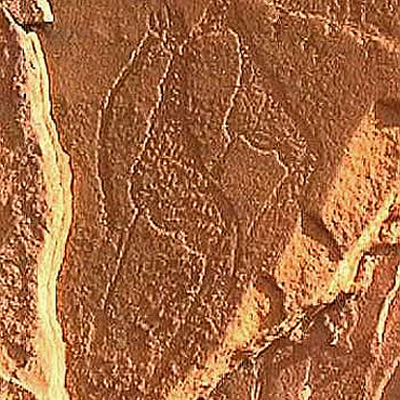 |
 |
APPENDIX 2 - TWYFELFONTEIN SITE REPORT BY SVEN OUZMAN |
1/18 |
| |
|
Site 1 – Nördlich des Zeremonienplatzes |
Site R on Scherz’s Map (Site 1 in
Figure 2)
S 20° 33’ 53’’ / E 14° 21’ 52”
Site Description
Twyfelfontein 534.1 is also known (and indicated on 1:50.000 topo-cadastral maps) as ‘Adam & Eva’ though this is not the ‘Adam & Eva’ recorded by Scherz, who labelled the Nördlich des Zeremonienplatzes site ‘R’. The site is located NW of the new and deeply problematic and archaeologically insensitive ‘Twyfelfontein Country Lodge’ and consists of a huge stand-alone block-like outlier of Etjo sandstone. This vast block of rock has several components with a spire-like element in the centre and rock jumble to the west, and large rock shelters to the east and south. The site has good views to the north and east and a seasonal river flows after rains 30 m north of the site. The site is located on the flat section 80m away from the slope of the upland on the 550m contour. There is a noticeable echo in the south-west of the site.
Associated Archaeology
All around this site and especially in the eastern and southern rock shelters, there are numerous ‘lithics’ or stone tools of every description on the surface of the site. These lithics all belong to the Later Stone Age, which covers the period from about 25000 years ago until historic times. The raw materials used for these lithics are varied. Most of these are made from white quartzite. There are also opalines – a crypto-crystalline silicate rock that forms in volcanic pipes and which then occurs either as nodules in rock strata or get washed down streams. There is also hornfels (also known as lydianite or indurated shale). This raw material is everywhere available in the form of river cobbles. Every stage of stone tool manufacture is present at this site. There are cores – large lumps of rock from which stone tools are made. There are flakes – general-purpose cutting tools. Adzes are present and were used for woodworking in much the same way as a spokeshave. End and side-scrapers, often in the shape of a thumbnail were used to prepare leather. There are also rare burins and awls – used to pierce. In addition to the stone tools, there are small pieces of grit-tempered, undecorated pottery fragments. There is also some bone and charcoal and a few metal items of recent vintage. The pottery may belong to herders or early farmers who used the site. The depth of deposit in the site is hard to determine because of its size and because of the hard, consolidated earth, but it does exceed 400mm in places, especially in the eastern shelter. There are some flat abraded patches that represent rock on which material such as plant food and possibly ochre was ground fine. Worryingly, the southern shelter’s surface scatter has been severely displaced by an attempt to clear this site’s floor and the surface artefacts occur like tide marks on the margins of the shelter. The site is home to Bushman and Khoekhoen rock engravings, Bushman rock paintings and cupules.
Figure 66
Click for Enlargement
Figure 65
Click for Enlargement
Description of Twyfelfontein R
There are approximately 65 images at this site. Northern side: This side is notable for the two giraffe (
Figure 65) engraved there in a fine pecked-infill, each with a strange proboscis continuing from its snout (not a nasal or oral emission - animal 660mm long) (Van Hoek 2003a). There is one large giraffe 560mm x 400mm long in a deep pecked outline and a partial pecked infill. The big head is emphasised as are the chest, head and rump in a manner that may be termed the ‘Twyfelfontein manner’ or style. There are also two pulses of geometric engravings here – probably made by Khoekhoen herders – which consist of joined and multiple circles as well as a ‘half-dumbbell’ motif (
Figure 66).
Eastern side: There are two deep pecked outline and one fine-pecked infill zebra engraved with a 340mm long wildebeest of buffalo image. There is a 510mm tall pecked outline giraffe that looks to have been renewed by re-pecking and has algae or lichen growing on it. There is a thick curved pecked area below an area of natural grooves. A small 320mm x 400mm remnant of case-hardened Etjo sandstone bears the remains of red rock paintings in the form of two human torsos and a black quadruped body. In the northern and deeper part of the shelter is a 1.2m x 0.4m cluster of rock paintings: a 530mm tall finely painted white giraffe with intricate patterning and red dorsal stripe. Next to it is a 310mm tall human figure (
second photo) with arms raised and painted all in red. There are also two white gnu-like animals. There are a further three red blobs, a black animal, remains of a red animal and two black human figures. Above and to the right of this image cluster there are 6 incised equids, of which one is definitely a representation of a zebra (210mm long) as well as a possible foal. Interestingly, these incised equids have been engraved on a piece of rock that has natural zebra-like patterning. Below these images is a rough pecked infill zebra with snout, a smaller pecked infill animal and a 3-toed engraved footprint.
Southern side: This is a large shelter, very high and voluminous. This shelter connects to the northern side via long natural passage between the split rock. On the western wall of this passage are several engravings. First, just above eye level there is a double row of at least 12 opposed depressions that are probably cupules, measuring between 18.2mm – 25.2mm diameter and 3mm – 4mm depth. ‘Cupules’ are small, semi-hemispherical hollows that humans have ground into or pecked out of the rock - similar in shape and size to half a ping-pong ball. Cupules are not grinding hollows as they are either usually too small or they occur on very steeply sloping surfaces. The meaning of cupules is, as yet, unclear, but they seem to represent a way to mark certain categories of space and place. 2m deeper into the passage there are three large pecked outline engravings – a 940mm x 620mm black rhino, a 310mm x 280mm antelope (?springbok) and a 200mm x 110mm ostrich that has been re-scratched.
Western side: In this rock jumble there is a large rock that has slipped and fallen onto another rock, leaving a narrow triangular gap between the two (Van Hoek 2002). On the uppermost surface of the lower rock is an interesting 1.9m x 0.9m (the rest of the case hardened upper rock surface is missing) cluster of geometric imagery that was probably made by the Khoekhoen. This collection of circles within circles and clusters of cupules within circles is very particular and reminiscent of the geometric imagery on the ‘Dancing Kudu’ engraved and abraded at the main site complex. These cupules are between 16mm – 42.7mm diameter and 2.7mm – 8mm deep. Two of the circular motifs – in rough pecked infill & outline have short ‘tails’ coming off them. There is a crescentic arc of 6 dot-cupules.
There are episodic engravings on the loose rocks. High on the southern end of the big central rock block there are three engraved zebra – one of which has no head and a scratched-in body. These zebra, 430mm and 370mm long, have a deep pecked outline and lighter infill pecked interior.
Threat(s) to site: There is a hiking trail that passes through the site. Unguided visitors have the potential to cause harm. The clearing of the surface artefacts in the southern shelter represents an episode of vandalism – even if it was done unintentionally. There is a lot of charcoal and stone-scratched graffiti, one of the most recent being ‘27/07/00’. There are also two animals that have been engraved very recently. The Etjo sandstone occurs in very fine layers, which break off easily.
→
A Survey into the Relationship between
Animal-Engravings & Cupules
→
The Rock Art of Twyfelfontein
→
The Rock Art of Namibia
→
The African Rock Art Archive
→
Bradshaw Foundation
Like us on Facebook & Follow us on Twitter to receive news & updates:











